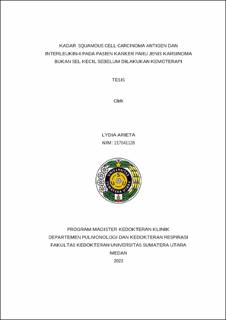| dc.description.abstract | Background and Aims: Lung cancer is the leading cause of malignancy in the world, reaching
up to 13 percent of all cancer diagnoses. In the United States, it is estimated there were around 213,380 new cases in 2007, 160,390 deaths due to lung cancer. Currently, China has the highest incidence and death rate by due to lung cancer, with the increasing number of younger patients who affected compared with the last 20 years. Cancer registration data Home Dharmais' illness in 2003-2007 showed that cancer of the trachea, bronchus and Lungs are the second most common malignancy in men (13.4%) after cancer nasopharynx (13.63%) and is the most common cause of cancer death in men (28.94%). American Lung Association data from 2004 revealed risk factors smoking is the cause of 90% of lung cancer deaths in men and woman. SCCA has also been widely used as a tumor marker for monitoring Non-Small Cell Lung Cancer (NSCLC), despite recent reports has value in routine tests because of its low sensitivity. Concentration SCC serum is reported to correlate with tumor stage, tumor size, remnants tumor after treatment, recurrence of disease, and survival patients with non-small cell lung cancer. Serum IL-6 concentrations are increased in lung cancer. There is a strong positive relationship between serum IL-6 concentration with tumor size, tumor stage, and progression lung cancer disease.
Methods: This was a descriptive study with total sampling 20 patients lung cancer. Blood sampling was used with serum. ELISA platform (semi-quantitative) was used to rate SCCA and IL-6 serum. The data of serum levels collected and statistically analyzed.
Results: The SCC-Ag value of NSCLC patients being the sample for this study shows that as many as 20 samples (100%) SCC-Ag levels were within normal limits and did not show an increase or increase range 0-2ng/ml. IL-6 values in NSCLC patients being the sample for this study showed that levels of IL-6 increased by as much as 15 samples (75%), and 5 IL-6 levels were still within the normal range sample (25%).
Conclusion: The tumor marker SCA and the inflammatory marker IL-6 can be found in high levels in NSCLC patients. | en_US |




